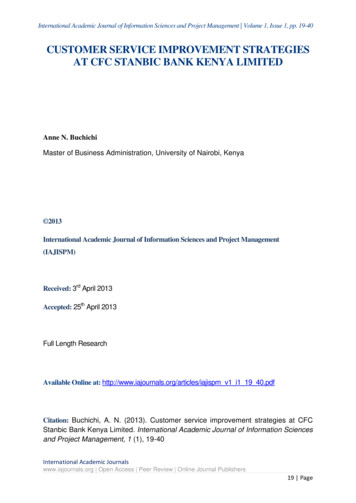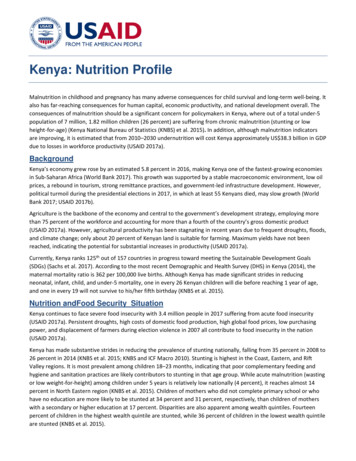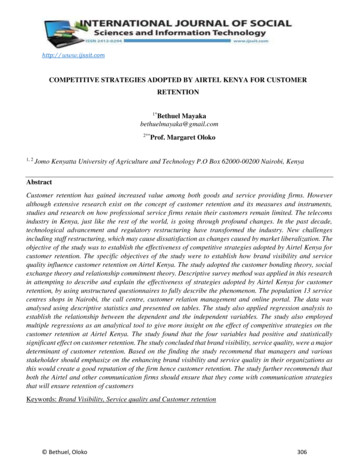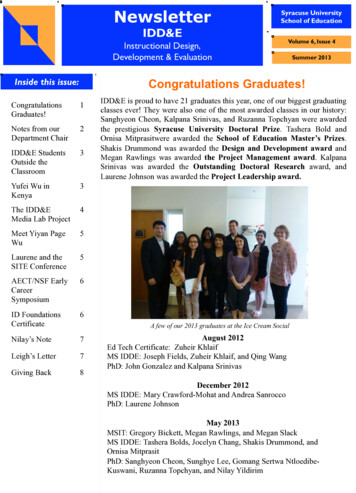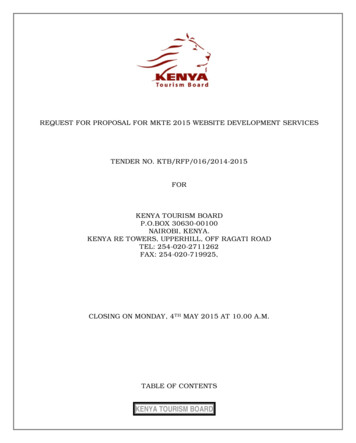
Transcription
EFFECT OF NUTRITION ON GROWTH AND DEVELOPMENT IN EARLYCHILDHOOD PRIMARY EDUCATION IN RONGO DMSIONRONGO DISTRICT NYANZA PROVINCEKENYAByFREDRICKO SEDA.BED/13846/62/DFA RESEARCH REPORT PRESENTED TO THE INSTITUTE OF OPENAND DISTANCE LEARNING IN PARTIAL FULFILLMENT OFTHE REQUIREMENT FOR THEAWARD OF BACHELOR OFEDUCATION-ECPE OF KAMPALAINTERNATIONALUNIVERSITYAPRIL 2010.
DECLARATIONI , do declare that the material in this book has been done entirely by my effort and hasnot been presented else where for any academic qualification.SIGNED!?. f . fQ.DATE . /.?. :.11
APPROVALThis research report is submitted for examination with my approval as a UniversitySupervisor.MR' Tindi SejeSUPERVISORDATE:({l;t-. .t l . .-f)-ft . l . ill
DEDICATIONFrom the well of my being, I dedicate this work to my beloved wife Melly, son Grandand daughter LynnIV
ACKNOWLEDGMENTIn the first place, I highly acknowledge the almighty God, for all he has done in my lifeup to this level of academic epitome. I also extend my heart felt gratitude to my belovedParents - -who taught me how to appreciate the sweetness of education.I am sincerely grateful to all those who sacrificed their valuable time out of their kindnessto assist me in all ways possible during the study. I extend my special thanks to all mylecturers and mostly my Supervisor Mr. Tindi seje who willingly devoted a lot of time togive me the best guidance and concentration, which has enabled me to complete thiswork successfully.May God richly bless you.V
DEFINITION OF TERMSThe following terms have been defined in the context of this research;Effects: the result that something bringsDevelopment: children gradually growing and becoming strong.Growth: the development of childrenInfection: the act or process of causing or getting a diseaseNutrition: the process in which primary pupils receive food necessary for them to growhealthy.Malnutrition: a poor condition of health caused by a lack of food or the right food.VI
TABLE OF CONTENTSDeclaration. .iiApproval . .iiiDedication. .ivAcknowledgement. . VDefinition of terms . viTable of contents . viiList of tables . xiList of charts . XiiAbstract. .xiiiCHAPTERONE1.0 Introduction . 11.1 Background of the study . !1.2 Statement of the problem . 31.3 purpose of the study . .41.4 Objectives of the study.41.5 Research questions . 41.6 scope of the study . 51.7 Significance of the study . 5CHAPTER TWOLITERATURE REVIEW2.0 Introduction . . . . . . . . . . . . . . . . . . . . . . . . . . . . . . . . . . . . . . . . . . . . . . . . . . . . . . . . . . . . . . . . . . . . . . . . . . . . 6Vil
CHAPTER THREERESEARCH METHODOLOGY3.0 Introduction . 123.lResearch design . 123.2 environment. . 123 .3 respondents . 123 .4 instruments . 123.5 Data collection procedures . .133.6 statistical treatment of data . .13CHAPTER FOURFINDINGS AND INTERPRETATIONS4.1Introduction . 14CHAPTER FIVEDISCUSSION, CONCLUSION AND RECOMMENDATION5.1 Introduction . .315.2 discussion . 315.3Conclusions . .325.4 Recommendations . .33REFERENCES . 34APPENDICESAppendix A- Questionnaire . .37Appendix B- FGD guides . .40Appendix C - Transmittal letter . .41.Appendix D - Time schedule . .42.Appendix E- Budget . .43Vlll
LIST OF TABLESTable 1 profile of the respondents.Table 2: Do you have nutritional programs in the schoolTable 3 how nutrition has affected the growth of childrenTable 4 do you have children with disabilities due to poor nutrition?Table 5 poor nutrition leads to poor performance of pupils in class.Table 6 children do not concentrate in class because of hunger.Table 7 poor nutrition leads to low enrollment of pupilsTable 8 Pupils miss classes because of poor nutritionTable 9 poor nutrition hinders the achievement of education.Table 10 well fed children perform well in classTable 11 do parents know the importance of nutrition on educational outcome.Table 12 children from poor families do not perform well because they do not have whatto eat.Table 13: Children who are sick due to malnutritionTable 14 how important is nutrition on early childhood and primary educationIX
LIST OF CHARTSChart 1 effects of nutrition on the growth of the childrenChart 2 do you have children with disabilities due to poor nutrition?Chart 3 children do not concentrate in class because of hunger.Chart 4 Pupils miss classes because of poor nutritionChart 5 poor nutrition hinders the achievement of educationChart 6 children from poor families do not perform well because they do not have what toeat.Chart ?Children who are sick due to malnutritionChart 8. Importance of nutritionX
ABSTRACTThe purpose of this study was to determine the effects of nutrition on growth anddevelopment in early childhood primary education in Rongo Division, Rongo DistrictKenya.The specific objectives of the study were to determine the effect of nutrition of earlychildhood and primary education pupils in relation to: growth and developmentSchool, achievement, Health and Determine the importance of nutrition on earlychildhood and primary education pupils.The methods used for data collection were questionnaires to the teachers and focus groupdiscussions with the pupils and interviews with the parents.The findings revealed nutrition had an impact on the growth and development of a childand also affected his/her educational achievements and health.The study recommended that. The government should make sure that it focuses onnutritional and feeding programs in schools.The parents and the community should be sensitized on the importance of nutrition onearly childhood and also taught how to feed their children what is right and important.Xl
Chapter one1.1 Background of the studyMalnutrition and infection are widespread in almost all developing countries. Among themost common conditions are protein-energy malnutrition (PEM). micronutrientdeficiency disorders, helminthic (worm) infection, and upper respiratory illness. Theseconditions often combine to create negative synergies; thus, for example. PEM andinfection frequently co-exist and multiply the ill effects that each would cause theorganism if present alone.( Grantham-McGregor, S., C. A. Powell. S.P. Walker and J.H.Himes 1991)Chronic food deficits affect about 792 million people in the world (FAO 2000), including20% of the population in developing countries. Worldwide, malnutrition affects one inthree people and each of its major forms dwarfs most other diseases globally (WHO,2000). Malnutrition affects all age groups, but it is especially common among the poorand those with inadequate access to health education and to clean water and goodsanitation. More than 70% of children with protein-energy malnutrition live in Asia, 26%live in Africa, and 4% in Latin America and the Caribbean (WHO 2000).The endemic nature of malnutrition and infection is probably also at the root of additionalhealth problems that impede learning among school-aged children. Poor vision andauditory impairment, for example, are conditions that directly relate to infection andmicronutrient deficiencies. (UNESCO 2000)Vast numbers of school-aged children in developing countries face major health andnutrition problems that adversely affect their ability to take advantage of the limitededucational opportunities available to them. Many of these children have a history ofPEM as well as current nutritional deficiencies including deficits in body stores of iodine,vitamin A and iron. These conditions are exacerbated by helminthic infection which ishighly prevalent among school-aged children and particularly inimical to their healthygrowth, development and educational progress. Temporary hunger and sensoryimpairment are also widely prevalent conditions (despite the fact that exact numbers are1
unknown) that vitiate attempts made by children and their families to reap the benefits ofclassroom instruction. (FAO 2000)A World Bank report (2000) warns unless action is taken within the first two years of achild's life to improve nutrition, children will suffer irreparable damage, ultimatelyadversely affecting the country's economic growth therefore need for the study.1.2 STATEMENT OF THE PROBLEM.Malnutrition is among the most serious health problems in the world today that has notbeen taken serious. Most people do not take nutrition as something important and yetwhen a child is well fed he she will perform well in school. It is the lack of people'sattention to children's nutrition and the impact it has on their growth that I took up thestudy.1.3 PURPOSE OF THE STUDYThe purpose of the study was to investigate the effects of nutrition on growth anddevelopment of early childhood and primary education pupils.1.4 OBJECTIVES OF THE STUDYThe general objective of the study was to investigate the effects of nutrition on growthand development of early childhood and primary education pupils.Specific objectives.Specifically this study seeks to;1. Determine the profile of the respondents in regards to:agegenderclass2
2. To determine the effect of nutrition of early childhood and primary educationpupils in relation to:growth and developmentSchool achievementHealth3. Determine the importance of nutrition on early childhood and primary educationpupils.1.5 Research questions1. What is the relationship between nutrition of early childhood and primaryeducation pupils and growth and development?2. What is the relationship between nutrition of early childhood and pnmaryeducation pupils and school achievement?3. What is the relationship between nutrition of early childhood and pnmaryeducation pupil and their health?4. What is the importance of nutrition on early childhood and primary pupils?1.6 Scope of the studyThe study was carried in Rongo district, Rongo division in Kenya.1.7 Significance of the studyHealth and nutrition is very important in the growth and development of children whichis in turn important in their education and therefore policy makers will make policies thattake into consideration the well being of the children in primary schools by improvingtheir nutrition.Schools will take into consideration the importance of feeding programs in schools andalso realize that nutrition is important in the improvement and better performance inclass.3
Parents will therefore learn the importance of nutrition and therefore review their feedinghabits.1.8 DEFINITION OF TERMSFor the purpose of the study the following terms are definedEffects: the result that something bringsDevelopment: children gradually growing and becoming strong.Growth: the development of childrenNutrition: the process in which primary pupils receive food necessary for them to growhealthy.Malnutrition: a poor condition of health caused by a lack of food or the right food.4
CHAPTER TWO2.0 IntroductionThis chapter reviews literature as an account of the knowledge and ideas that have beenestablished by accredited scholars and experts in the field of nutrition on the developmentof primary children. It is guided by the objectives of the study outlined in chapter one.2.1 impact of nutrition on primary children.2.1.1 Growth and developmentNutrition is essential for growth and development, health, and well-being. Propernutrition, health care, and stimulation during the early years improve learning and otherabilities. Nutritional Programs facilitate the development of a child in all its dimensionsand have considerable long-lasting effects on the child's life. (Levinger beryl 2000)Poor nutrition during the first 3 years often permanently hampers a child's mentaldevelopment. Some children start out growing well but over time begin to fall off, both inweight gain and then in height. If the condition progresses, FIT children may becomeapathetic and irritable and may not reach milestones, such as sitting up or walking at theusual age. It is possible that FTT children don't process needed nutrients as efficiently asnon-FTT children and that this results in central nervous system defects, such ashyperactivity and disorders of attention and learning. (Grantham-McGregor 1991)2.1.2 School achievementA child's school enrollment. Attendance and achievement are influenced by a host ofvariables including the capacity of the child as a biosocial organism to process andrespond to stimuli. (Grantham-McGregor et al 1991)As the quality ofbiosocial organisms sitting in the classroom improves, so too does theefficiency of the child's learning. (WHO 2000) Nutrition and health problems impinge on5
the quality of the biochemical organism and impinge the accusation of skills and abilitiesneeded to progress satisfactorily in the primary education.According to MOEST (2004) by ensuring the health and nutrition of the learners, theirminds are receptive in learning.2.1.3 HealthMalnutrition poses a serious threat to children's health and development, especially forthe youngest children who are in a uniquely vulnerable period of rapid growth anddevelopment.Malnutrition among young children is linked with poor health and increased risk ofhospitalizations. (Cravioto, J. and Patricia Cravioto 1990)"Malnutrition in all its forms increases the risk of disease and early death. Protein-energymalnutrition, for example, plays a major role in half of all under-five deaths each year indeveloping countries (WHO 2000). Severe forms of malnutrition include marasmus(chronic wasting of fat, muscle and other tissues); cretinism and irreversible braindamage due to iodine deficiency; and blindness and increased risk of infection and deathfrom vitamin A deficiency.The state of health is influenced by nutrition, medical care, environmental factors andsocial economic mental status of the child.Deficiencies before birth and in the first five or so years of a child's life can cause mentalretardation. In particular for this matter young children need plenty of protein whichpromotes healthy growth; most young people are also active and hence need adequatesupplies of energy foods as well as vitamin and minerals to make sure that their bodyfunctions normally. (Grantham-McGregor 1991)6
2.2 importance of nntrition on early childhood and primary education pupils.Recent studies from the nutrition and economics literatures reaffirm the importance ofnutrition for the cognitive achievement and school enrollment of children. Nutrition isalso important for development of a country because if the children are healthy they willstudy well and therefore are future leaders. (Berkeley Seth and dean Johnson 1991)Nutrition is essential to a child's health. Good nutrition can put a stop to many healthproblems, including becoming overweight, developing weak bones, and developingdiabetes. Giving a child all the foods that have all the important nutrients will helphim/her grow to her/his complete potential. A child's body prospers on certain nutrientsthat work together to promote growth and development.( WHO 2000)Adequate supplies of food as well as vitamin and minerals make sure that children's bodyfunctions well and therefore perform well in school. (Latham m.et al 1991)7
CHAPTER THREERESEARCH METHODOLOGY3.1 DesignThis study used a descriptive design. The research drew from both the qualitative andquantitative analysis approaches in order to get a bigger picture both in number and data3.2. EnvironmentThis study was conducted in primary schools in Rongo division, Rongo district, Kenya.And this was so because it is where the researcher lives and therefore it was easy to getinformation. The costs of transport was reduced.3.3. RespondentsThe respondents included teachers, pupils and parents.25 Questionnaires were distributed to teachers randomly and ten parents werepurposively selected for interview while 25 pupils were to participate in focus groupdiscussions.3.4. Instruments of data collectionQuestionnaires were used to extract information form teachers. Focus group discussionswere used to get information from pupils and interviews were carried out with theparents. Open ended questionnaires were suitable for investigating deeper the subjectmatter. It was easier to get information from the parents in interviews than withquestionnaires because getting them back was a problem while for the teachers it waseasy because they were all in one place and that was the school.3.5. Data collection procedureA letter of introduction from the institute of continuing education was to facilitate in thedata collection exercise. The letter was handed to the head teacher before Questionnaireswere distributed to teachers and focus group discussions carried on with pupils. The8
parents were interviewed from their homes and the data collected were sorted andcategorized after which it was analyzed. The conclusions and recommendations weremade.3.6. Statistical treatment of dataThe frequencies and percentages were used to determine the number of samplerespondents used in the research process and the number that participated positively incontribution to the research.Formula;Percentage(%) Ex 100Total number of respondentsWhere F number of respondentsObservedQualitative analysis; Data from questionnaires was standardized hence requiringcategorization. Such data was presented in a descriptive form above which were used todiscuss the results of quantitative data.9
CHAPTER FOUR4.1 FINDINGS AND INTERPRETATIONS.The chapter is a presentation; interpretation and discussion of the findings. The resultsare presented in form of tables and frequency counts and percentage. It focuses on theeffects of nutrition on growth and development in early childhood primary education inprimary schools in Rongo Division Rongo district, Kenya4.2 Profile of the respondentsTable 1: Shows the profile of the 9-24 yrs42025-30yrs105031 and 0SexMarital statusAgeEducational levelSource: field data10
Twenty five (25) questionnaires were distributed to the teachers and 20 were filled andreturned .This therefore represents 80% of the total number of questionnaires that weredistributed.The study covered 20 randomly selected teachers of whom 11 (55%) were male and 9(45%) were female.Of the 20 respondents, 8 (40%) were single while 12 (60%) were married.The age category of the respondents was divided in three groups that is 19-24 years were4 which was 20%, 25-30 were 10 (50%) and 31 and above were 6 representing (30%) ofthe respondents.The academic level of the respondents was divided in three categories that is certificate,diploma and degree. 6 (30%) of the respondents had certificates, 9 (45%) had diplomasand 5 (25%) had degrees.Interviews were carried out with 10 parents both male and female.Six 6 of the parentswere male while four 4 were female.Focus group discussions were used to extract data from the pupils. 25 pupils wereincluded in the discussion of which 14 were boys and 11 girls.4.3 Growth and development.The respondents were asked whether they have nutritional programs in the school andthis was their response.11
Table 2: Do yon have nutritional programs in the l20100Chart 1do you have nutritional programs65% The table and chart show that 13 (65%) of the respondents agree that they havenutritional programs in the school and 7 (35%) disagree. According to the parents theschool they took their children to had nutritional programs and according to them it isimportant to take children to schools with nutritional programs because it is acontributing factor to educational achievement. In a focus group discussion with thepupils they also agreed that the school provided them with food at lunch time andporridge at break time and therefore they concentrated well in class.The respondents were asked how nutrition has affected the growth of children and thiswas their response.12
Table 3 how nutrition has affected the growth of sitively1575Remained the same525Total20100Chart2effect of nutritonal programs onchildrens growth0%25% - - - . - - - - - - Negati\ely Positi'.ely Remained thesame15 (75%) of the respondents said that nutrition has positively affected the growth ofchildren and 5 (25%) said they have remained the same. Accordiog to the parentsnutritional programs have positively affected their children's growth that is they arehealthy and perform well in class.13
The respondents were asked weather they have children with disabilities due to poornutrition and this was their responseTable 4 do you have children with disabilities due to poor otal20100Chart 2.do you have children with disabilitiesdue to poor nutrition15% 85%The table shows that 3 (15%) of the respondents agreed that they have children withdisabilities due to poor nutrition while 17 (85%) disagreed.Some parents revealed that they had children who were disabled due to poor nutritionespecially those who were not well fed when young. They revealed that some hadlearning disorders and could not participate well in class.14
4.4 School achievementThe respondents were asked weather poor nutrition leads to poor performance of pupilsin class and this was their responseTable 5 poor nutrition leads to poor performance of pupils in class.ResponseFrequencyPercentageStrongly agree1050Agree840Strongly disagree--Disagree210Total2010010 (50%) of the respondents strongly agree that poor nutrition leads to poor performanceof pupils in class while 8(40%) agree and 2 (10%) disagree. The parents agreed thatfeeding children contributed their academic performance because children who arehealthy are capable to concentrate in class which leads to performing well.The respondents were asked whether children do not concentrate in class because ofhunger and this was their response15
Table 6 children do not concentrate in class because of hunger.RespondentsFrequencyPercentageStrongly agree1575Agree210Strongly disagree15Disagree210Total20100Chart3children do not concetrate in classbecause of hunger5%10%10% I 75%Strongly agree Agree Strongly disagree Disagree16
15(75%) of the respondents strongly agreed that pupils do not concentrate in classbecause of hunger, 2 (10%) agreed while 1(5%) strongly disagreed and 2(10%)disagreed. the parents said that it was obvious one could not concentrate on an emptystomach especially children. The pupils revealed that in some cases when the teacherdelays them in class and they have to go for lunch they do not concentrate in class. Theyalso revealed that in some cases the food is not prepared in time and therefore thechildren feel bad and some more especially in lower classes start crying.The respondents were asked weather poor nutrition leads to low enrollment of pupils andthis was their responseTable 7 poor nutrition leads to low enrollment of pupils.ResponseFrequencyPercentageStrongly agree840Agree630Strongly disagree210Disagree420Total20100The table shows that 8 (40%) of the respondents strongly agree that poor nutrition leadsto low enrollment of pupils, 6 (30%) agree while 2 (10%) strongly disagree and 4 (20%)disagree. According to the parents children who are not well fed always fall sick andtherefore cannot attend school which means that the enrollment is affected.The respondents were asked weather pupils miss classes because of poor nutrition andthis was their response17
Table 8 Pupils miss classes because of poor nutrition.ResponseFrequencyPercentageStrongly agree630Agree840Strongly disagree210Disagree420Total20100Chart4becouse of poor nutrition pupilsmiss classes i 60 20Cl C.- 0 '1I IC7234response6 (30%) of the respondents strongly agreed that because of poor nutrition pupils missclasses, 8(40%) agreed while 2 (10%) strongly disagreed and 4 (20%) disagreed.18
According to the parents many children miss classes because they have not had anythingto eat and sometimes they refuse to go to school because they have nothing to eat there.The pupils revealed that they could not attend classes when they were hungry andsometimes they missed classes because of sickness which could be caused by poornutrition for example diarrhea and stomachache.The respondents were asked weather poor nutrition hinders the achievement of educationand this was their response.Table 9 poor nutrition hinders the achievement of education.ResponseFrequencyPercentageStrongly agree1155Agree630Strongly disagree--Disagree315Total2010019
Cbart5poor nutrition hinders education15%1o Strongly0%?""'-------130%,agree Agree55%,o Strongly disagreeo DisagreeThe table shows that 11(55%) of the respondents strongly agreed that poor nutritionhinders the achievement of education, 6 (30%) agreed and 3 (15%) disagree.The parents agreed that poor nutrition hindered academic achievement in a way that ifpupils cannot concentrate in class then the performance will not be good which leads torepletion and hence school drop out. This means that the goal of government is notrealized that is achieving education for all.20
The respondents were asked whether children who were fed in the early years performand learn well in class and this was their response.Table 10 well fed children perform well in classResponseFrequencyPercentageStrongly agree1050Agree525Strongly disagree15Disagree420Total2010010 (50%) of the respondents strongly agree that children who were well fed in early yearsperform and learn well in class, 5 (25%) agree while 1 (5%) strongly disagree and 4(20%) disagree.The parents agreed that it was obvious children who were well fed in their early agesgrew up to be strong and healthy. They stressed the importance of early childhoodfeeding and therefore called for parents to make sure they fed their children and right intheir early years.21
The respondents were asked weather most parents do not know the importance ofnutrition on educational outcome and this was their responseTable 11 do parents know the importance of nutrition on educational outcome.ResponsefrequencyPercentageStrongly agree945Agree525Strongly disagree210Disagree420Total201009 (45%) of the respondents strongly agree that most parents do not know the importanceof nutrition on educational outcome, 5 (25%) agree while 2 (10%) strongly disagree and4 (20%) agree.The parents disagreed that they knew the importance of nutrition on academicachievement and revealed that the hindrance to good nutrition was poverty that is someparents do not have enough money to buy what is important for the children.The respondents were asked weather children from poor families do not perform well inschool because they do not have what to eat and this was their response.22
Table 12 children from poor families do not perform well becanse they do not havewhat to eat.ResponseFrequencyPercentageStrongly agree220Agree315Strongly disagree525Disagree1050Total20100Chart 6 .children from poor families do not perform well because they do not havewhat to eat.23
45%g18% 1 214%23% 3 4The table and chart show that 2 (10%) of the respondents strongly agree that childrenfrom poor families do not perform well because they do not have what to eat, 3(25%)agree while S (25%) strongly disagree and 10 (50%) disagree.most parents interviewed agreed that they did not have enough money to buy food forthe children and therefore the children
apathetic and irritable and may not reach milestones, such as sitting up or walking at the usual age. It is possible that FTT children don't process needed nutrients as efficiently as non-FTT children and that this results in central nervous system defects, such as hyperactivity and disorders of attention and learning. (Grantham-McGregor 1991)

